What's New
Displaying results 2211 - 2220 of 4052
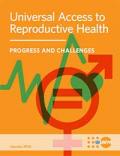
Resource | Publications,
Universal access to reproductive health affects and is affected by many aspects of life. It involves individuals’ most intimate relationships, including negotiation and decision-making within these relationships, and interactions with health providers regarding contraceptive methods and options.
This report seeks to identify areas where reproductive health has advanced or not according to four main indicators: Adolescent birth rate, contraceptive prevalence rate, unmet need for family planning rate, proportion of demand for contraception satisfied.
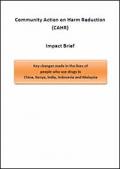
Key Changes Made in the Lives of People who Use Drugs in China, Kenya, India, Indonesia and Malaysia
Resource | Publications,
Community Action on Harm Reduction (CAHR) is an ambitious programme implemented between 2011 and 2015 with the objective of expanding coverage of HIV prevention, treatment and care, sexual and reproductive health and other services to more than 230,000 people who inject drugs (PWID), their partners and children in five countries – China, India, Indonesia, Kenya and Malaysia – and, since 2015, with the addition of Myanmar, through funding from the Social Department/Health and AIDS Division of the Ministry of Foreign Affairs of the Government of The Netherlands. Due to specific higher-risk behaviours, PWID are at increased risk of HIV irrespective of the epidemic type or local context; they often have legal and social issues related to their behaviours that increase their vulnerability to HIV.
This briefing document highlights the impact on the lives of PWID and their family members of the CAHR programme as well as the continued support needed by PWID to fully realise their right to quality health services that are evidence-based and free from stigma and discrimination.
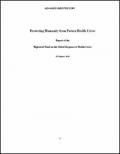
Resource | Publications,
In this context, the UN Secretary-General established the High-level Panel on the Global Response to Health Crises (the Panel) in April 2015 to propose recommendations that would strengthen national and international systems to prevent and respond effectively to future health crises, taking into account lessons learned from the Ebola response.
The Panel focused its attention on health crises arising from the outbreaks of new, acute or re-emerging communicable diseases that pose a threat of international spread. The Panel saw its task as being forward-looking in proposing critical measures that would better prevent and respond to future health crises. The report should not be considered as a critique of the Ebola response, as other reviews were more technically qualified to address this. Nevertheless, the Panel examined such reviews in-depth and used the global response to the Ebola outbreak as a point of departure for its deliberations.
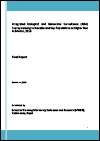
Resource | Publications,
This is the first Integrated Bio-Behavioral Surveillance (IBBS) Survey being conducted in Bhutan. Based on the recommendations of the formative assessment on feasibility of IBBS survey in Bhutan conducted in 2014, the IBBS was found to be feasible and acceptable among the High Risk Women (Drayang girls),Transport workers (taxi and truck drivers), armed forces and Drug Users including Injecting Drugs Users, MSM/TG and Migrants workers in Bhutan. The main aim of the survey is to understand the current prevalence of HIV and STI, sexual risk behaviors and vulnerability to HIV infection and the coverage of interventions among the key affected populations (KAPs).

Resource | Tools,
This manual addresses the early phase of implementation of GLASS, focussing on surveillance of resistance in common human bacterial pathogens. The intended readership of this publication is public health professionals and health authorities responsible for national AMR surveillance. It outlines the GLASS standards and describes the road map for implementation of the system between 2015 and 2019. Further development of GLASS will be based on the lessons learnt during this period.

Resource | Publications,
The Hong Kong STD/AIDS update is a composite report on HIV/AIDS reporting and STI caseload statistics published 3 monthly. The current issue has the updated information up to December 2015.
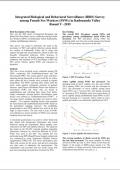
Resource | Fact Sheets,
This was the fifth round of the Integrated Biological and Behavioral Surveillance survey conducted among Female Sex Workers (FSWs) of Kathmandu Valley (Kathmandu, Lalitpur and Bhaktapur districts). This survey was aimed to determine the trend in the prevalence of HIV and syphilis infection among female sex workers of Kathmandu Valley and to assess and explore the high-risk sexual behaviors related to HIV and Sexually Transmitted Infections (STI), practices of condom use and use of family planning, experiences of symptoms and treatment of STI, knowledge of HIV and STI, sexual violence against FSWs and exposures to programs.
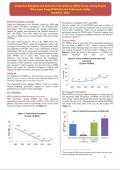
Resource | Fact Sheets,
The sixth round of the IBBS survey was conducted among PWIDs within the Kathmandu Valley with coverage of 340 sample size, funded by TI Pooled Fund, under the leadership of NCASC and in close collaboration with key stakeholders. The survey was carried out primarily to track the trends in the prevalence of HIV and syphilis infection among male PWIDs and to assess their sexual and injecting behaviors. The surveys also explored the respondents’ knowledge of HIV and sexually transmitted infections (STI), the presence of STI symptoms, sexual and injecting behaviors, and exposure to HIV programs. For the first time in IBBS history this round has introduced Hepatitis C (HCV) and Hepatitis B (HBV) test and its prevalence among PWIDs.
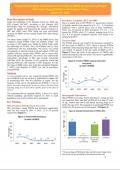
Resource | Fact Sheets,
The sixth of the IBBS survey was conducted among PWIDs within the Pokhara Valley with coverage of 345 sample size, funded by Global Fund, under the leadership of NCASC, Save the Children and in close collaboration with key stakeholders. The survey was carried out primarily to track the trends in the prevalence of HIV and syphilis infection among male PWIDs and to assess their sexual and injecting behaviors. The surveys also explored the respondents’ knowledge of HIV and sexually transmitted infections (STI), the presence of STI symptoms, sexual and injecting behaviors, and exposure to HIV programs. For the first time in IBBS history, this round has introduced Hepatitis C (HCV) and Hepatitis B (HBV) test and its prevalence among PWIDs.
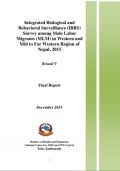
Resource | Publications,
This is the fifth round of Integrated Biological and Behavioral Surveillance (IBBS) survey conducted among 720 Male Labor Migrants (MLM) (360 migrants of Western Region and 360 migrants of Mid to Far Western Region). The survey was conducted in 11 districts of both the Regions (five districts: Kaski, Syangja, Palpa, Kapilvastu, Gulmi of Western Region and six districts: Banke, Surkhet, Kailali, Kanchanpur, Doti, and Achham of Mid to Far Western Region).





